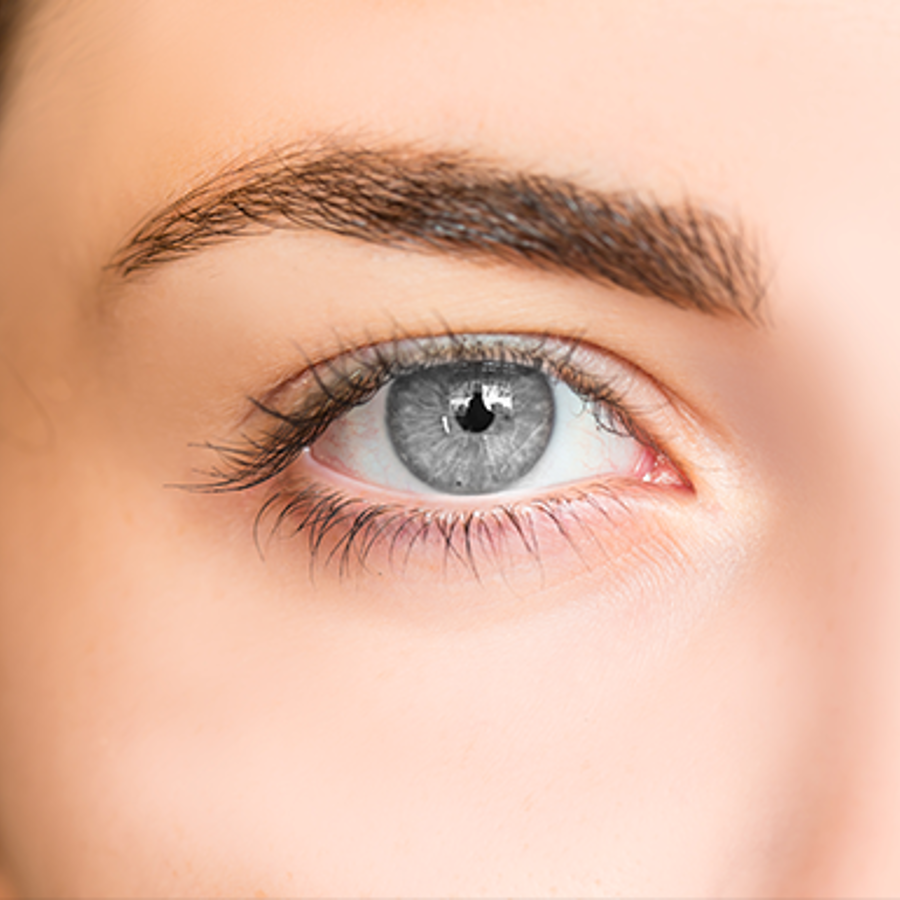
Are gray eyes the same as blue in terms of genetics?
September 21, 2007

- Related Topics:
- Eye color,
- Complex traits,
- Pigmentation traits
A curious adult from California asks:
“Are gray eyes the same as blue in terms of genetics?”
Scientists know a lot about the genetics of eye color. But mostly about blue, green and brown eyes.
Not many scientists have studied the differences between blue and gray eyes. This is probably because it is likely that the genetics of the two are very similar. But as you will read later on they are not exactly the same.
Although we do not know the exact genes that cause gray vs. blue eyes, we do know a lot about what makes different eye colors. When people talk about eye color, they are talking about the color of the part of the eye called the iris. The color comes from dye-like molecules called pigments.
Pigments are what give nature all of her colors. It is why some flowers are red and others are blue. And why some eyes are brown while others are blue.
The major pigment in the eye is the same as the one in skin and hair -- melanin. Different amounts of pigment in the iris lead to different eye colors.
This might seem weird at first since melanin is dark brown or black. How can this one color pigment be responsible for many colors including blue, brown, and gray? It has to do with HOW MUCH and WHERE the melanin is made in the eye.
There are two different layers in the iris, a front and a back one. In between the two layers is an area called the stroma.
The stroma is a clear tissue with many proteins floating around in it. One of these proteins is called collagen. We will get back to that later.
Almost all eye colors have a lot of melanin on the back layer of the iris. Most differences in eye color come from the amount of melanin made on the front layer.
For example, both brown and blue eyes have lots of melanin in the back layer. The difference is that brown eyes also have a lot of melanin in the front layer and blue eyes do not. So brown eyes are dark because lots of melanin in the front layer absorbs any light hitting the iris.
In blue eyes, though, light can pass right through the clear front of the iris and reflect off the melanin in the back of the eye. But the light doesn't reflect back through a completely empty stroma. The collagen in the stroma gets in the way of the light on its way back to the front of the eye. When the light hits the collagen it bends and looks blue.
It is just like the sky. The sky is dark in space but when we look at it from Earth during the day, it looks blue not black. This is because light from the sun hits particles in the atmosphere and reflects blue. This effect is called Rayleigh scattering.

Now imagine a sky on a rainy day. It looks gray right? That is because the light from the sun is reflecting on large drops of water. When the light hits the water drops, it looks gray or white because the larger particles scatter all of the wavelengths of light equally. This kind of scattering is called Mie scattering.
So we have one guess about why eyes look gray. Remember that the blue eye color is caused by light reflecting off of the protein collagen in the stroma. You could imagine that the amount or size of the proteins in the stroma could determine how gray the eyes appear. Just like clouds on a rainy day.
We do not know genetically how the amount of collagen in the stroma is determined. Undoubtedly there are genes that determine this; we just don't know anything about them. This means we can't even guess at the genes that might be involved.
Another idea about gray eyes has to do with the amount and location of melanin. One theory is that dark gray eyes come from a thin layer of melanin on the front layer of the iris. The blue reflection of light is clouded over by the dark layer in front causing a dark gray color.
Light gray eyes are almost the opposite. One idea is that in light gray eyes, there is very little melanin on the front of the iris. Even less here than is found in blue eyes!

You can imagine the difference between blue and light gray eyes like a dimmer on a light switch. A little melanin in the front of the eye gives you blue eyes. As you decrease the amount of melanin present the blue eyes look lighter and lighter until they look colorless or light gray.
We don't know which of these ideas about gray eyes is right. It could be that different people have gray eyes for different reasons and so all of the ideas are right. Or there may be a completely different explanation. Scientists have a lot more work to do to find out the real story about the genetic differences between gray and blue eyes.
We do have a pretty good handle on figuring out why someone has brown eyes and someone else has blue, though. It may be that the same gene is involved in gray eyes.
The gene I am talking about is called OCA2. This gene gives the instructions for a protein, called P-protein that helps decide how much melanin is made.

Different people can have different versions of this gene. And some versions are better at making melanin than others. Which version you get determines the amount of melanin in the eye.
People who have a version of OCA2 that works poorly can have blue eyes. We could guess that people who have a version of OCA2 that works VERY poorly might have light gray eyes. Once scientists get around to looking, it'll be interesting to see if this is the case.
And OCA2 is just one gene that we know about. There are likely to be other genes that cause differences in how much melanin is made and where in the iris it is made.
Ultimately there are at least two things that could determine gray eye color. The first is the amount of melanin made. And the second is the density of the proteins in the stroma. Genetics is bound to have a role in both of these things.

Author: Lucy Southworth
When this answer was published in 2007, Lucy was a Ph.D. candidate in the Department of Biomedical Informatics, studying gene expression changes in mammalian aging in Stuart Kim’s laboratory. She wrote this answer while participating in the Stanford at The Tech program.
 Skip Navigation
Skip Navigation
